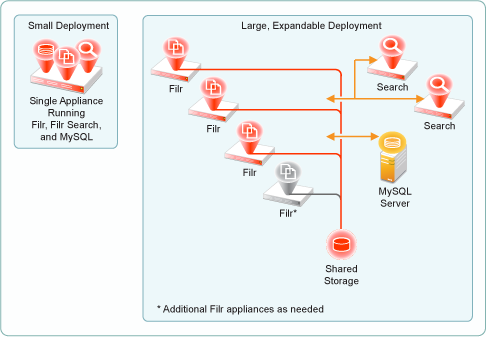1.0 Small or Large, Expandable Deployment?
Filr Deployment Scenarios
Three Filr deployment scenarios are possible:
-
Small Deployment: A single
all-in-one
Filr appliance that performs all of the functions. -
Large, Non-Expandable Deployment (no shared storage): One Filr appliance with no shared storage, two Filr Search appliances (recommended), and one MySQL appliance perform specific functions.
-
Large, Expandable Deployment (shared storage): One or more Filr appliances with shared storage, two Filr Search appliances, and one MySQL appliance perform specific functions.
Why Is there No Information about Large, Non-expandable Deployments in This Guide?
Creating a large, non-expandable deployment is not a best practice.
-
For small organizations, Small Filr deployments generally perform better than Large, non-expandable deployments due to network latency and other issues.
-
Large, non-expandable deployments offer only limited advantages over small deployments, such as:
-
Redundant Filr Search appliances
-
Potential utilization of existing in-house MySQL or MS SQL services
-
Small Vs. Large, Expandable
Before deploying Filr, you must determine whether your organization’s long-term needs dictate a small deployment or a large, expandable deployment. The information that follows can help you make that determination.
Figure 1-1 andTable 1-1 outline the fundamental difference between small and large, expandable deployments.
Figure 1-1 Components of Small and Large, Expandable Deployments

Table 1-1 Comparing Small, Large non-expandable, and Large-expandable Deployments
|
Feature/Component |
Small Deployment |
Large, Expandable Deployment |
|---|---|---|
|
Number of appliances |
One all-in-one appliance |
Recommended Minimum
|
|
Content Indexing Off-loading: |
None |
A special-purpose Filr appliance can be configured to not serve clients request but instead be dedicated to the resource-intensive function of content synchronization and indexing. |
|
Expansion This is the capability to meet increased demands from organization growth and/or Filr service usage |
None |
In theory, you can add as many Filr appliances as needed. In practice, as with any system, there are limitations external to Filr, such as network bandwidth, hardware limitations, and other constraints that become bottlenecks for Filr scalability and performance. |
|
Fault Tolerance |
None |
Filr Search Index servers are independent and redundant. Two index servers are sufficient |
|
High Availability |
Single point of failure |
With a load balancer deployed, two or more Filr Appliances can be attached to the same shared storage, which in turn can be protected by traditional clustering. |
|
Process specialization |
None |
You can devote one Filr appliance to Net Folder synchronization and content indexing. |
For more information on small and large deployments, see Overview
in the Novell Filr 1.1 Installation and Configuration Guide.